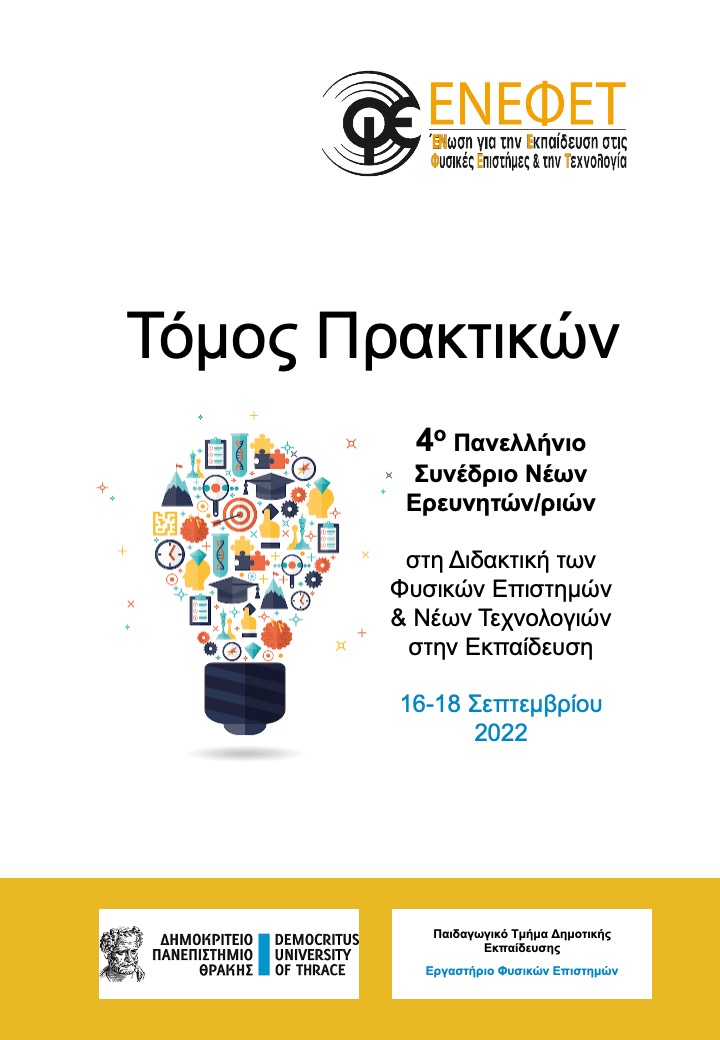ΕΝΝΟΙΟΛΟΓΙΚΗ ΑΛΛΑΓΗ ΣΤΙΣ ΦΥΣΙΚΕΣ ΕΠΙΣΤΗΜΕΣ: ΔΙΕΡΕΥΝΗΣΗ ΤΗΣ ΕΠΙΔΡΑΣΗΣ ΓΝΩΣΤΙΚΩΝ ΜΕΤΑΒΛΗΤΩΝ ΣΤΗ ΣΥΝΕΚΤΙΚΟΤΗΤΑ ΤΗΣ ΓΝΩΣΗΣ ΤΩΝ ΠΑΙΔΙΩΝ

Published:
Sep 14, 2024
Keywords:
conceptual change Neo-Piagetian Theory advanced methods of statistical analysis coherent and fragmented knowledge
Abstract
The purpose of this study is to contribute to the understanding of the nature of children's knowledge before adopting the scientific point of view. Specifically, it will be investigated whether pre-existing conceptions of physical phenomena are coherent or fragmented, whether the process of conceptual change is a linear or non-linear process, and to what extent it can be explained by the influence of cognitive variables in Neo-Piagetian Theory. In addition, advanced methods of statistical analysis will be applied in order to bring out strong scientific results. The present research is an innovative effort, as it includes possible prognostic variables and re-examines this critical issue with new methodological tools.
Article Details
- Section
- PhDs
References
Bahar, M. (1999). Investigation of biology students’ cognitive structure through word association tests, mind maps and structural communication grids. University of Glasgow.
Child, D., & Smithers, A. (1973). An attempted validation of the Joyce‐Hudson scale of convergence and divergence. British Journal of Educational Psychology, 43(1), 57–62. https://doi.org/10.1111/j.2044-8279.1973.tb00738.x
Clark, D. B. (2006). Longitudinal Conceptual Change in Students’ Understanding of Thermal Equilibrium: An Examination of the Process of Conceptual Restructuring. Cognition and Instruction, 24(4), 467–563. https://doi.org/10.1207/s1532690xci2404_3
DiSessa, A. A. (1993). Toward an Epistemology of Physics. Cognition and Instruction, 10(2–3), 105–225. https://doi.org/10.1080/07370008.1985.9649008
DiSessa, A. A. (2006). A History of Conceptual Change Research: Threads and fault lines. In R. K. Sawyer (Ed.), The Cambridge Handbook of the Learning Sciences (pp. 88–108). Cambridge University Press. https://doi.org/10.1017/CBO9781139519526.007
DiSessa, A. A. (2013). A Bird’s-Eye View of the “Pieces” vs. “Coherence” Controversy (from the “Pieces” side of the Fence). In S. Vosniadou (Ed.), International Handbook of Research on Conceptual Change (pp. 31–48). Routledge. https://doi.org/10.4324/9780203154472.ch2
DiSessa, A. A., Gillespie, N. M., & Esterly, J. B. (2004). Coherence versus fragmentation in the development of the concept of force. Cognitive Science, 28(6), 843–900. https://doi.org/10.1016/j.cogsci.2004.05.003
Efklides, A. (2008). Metacognition. European Psychologist, 13(4), 277–287. https://doi.org/10.1027/1016-9040.13.4.277
Ioannides, C., & Vosniadou, S. (2002). The Changing Meanings of Force. Cognitive Science Quarterly, 2(1), 5–61.
Kypraios, N., Papageorgiou, G., & Stamovlasis, D. (2014). The Role of Some Individual Differences in Understanding Chemical Changes: A Study in Secondary Education. International Journal of Environmental and Science Education, 9(4), 413–427.
Lawson, A. E. (1978). The development and validation of a classroom test of formal reasoning. Journal of Research in Science Teaching, 15(1), 11–24. https://doi.org/10.1002/tea.3660150103
Lawson, A. E. (1985). A review of research on formal reasoning and science teaching. Journal of Research in Science Teaching, 22(7), 569–617. https://doi.org/10.1002/tea.3660220702
Lawson, A. E., & Thompson, L. D. (1988). Formal reasoning ability and misconceptions concerning genetics and natural selection. Journal of Research in Science Teaching, 25(9), 733–746. https://doi.org/10.1002/tea.3660250904
Metallidou, P., & Platsidou, M. (2008). Kolb’s Learning Style Inventory-1985: Validity issues and relations with metacognitive knowledge about problem-solving strategies. Learning and Individual Differences, 18(1), 114–119. https://doi.org/10.1016/j.lindif.2007.11.001
Özdemir, G., & Clark, D. B. (2007). An overview of conceptual change theories. Eurasia Journal of Mathematics, Science and Technology Education, 3(4), 351–361. https://doi.org/10.12973/ejmste/75414
Pluess, M., Assary, E., Lionetti, F., Lester, K. J., Krapohl, E., Aron, E. N., & Aron, A. (2018). Environmental sensitivity in children: Development of the Highly Sensitive Child Scale and identification of sensitivity groups. Developmental Psychology, 54(1), 51–70. https://doi.org/10.1037/dev0000406
Schneider, M., & Hardy, I. (2013). Profiles of inconsistent knowledge in children’s pathways of conceptual change. Developmental Psychology, 49(9), 1639–1649. https://doi.org/10.1037/a0030976
Stamovlasis, D., Papageorgiou, G., & Tsitsipis, G. (2013). The coherent versus fragmented knowledge hypotheses for the structure of matter: an investigation with a robust statistical methodology. Chemistry Education Research and Practice, 14(4), 485–495. https://doi.org/10.1039/C3RP00042G
Vaiopoulou, J., Stamovlasis, D., & Papageorgiou, G. (2017). New Perspectives for Theory Development in Science Education: Rethinking Mental Models of Force in Primary School. In R. V Nata (Ed.), Progress in Education, Volume 47 (pp. 1–16). Nova Science Publishers, Inc.
Vosniadou, S. (1994). Capturing and modelling the process of conceptual change. Learning and Instruction, 4(1), 45–69. https://doi.org/10.1016/0959-4752(94)90018-3
Vosniadou, S., & Brewer, W. F. (1992). Mental models of the earth: A study of conceptual change in childhood. Cognitive Psychology, 24(4), 535–585. https://doi.org/10.1016/0010-0285(92)90018-W
Vosniadou, S., & Brewer, W. F. (1994). Mental Models of the Day / Night Cycle. Cognitive Science, 18(1), 123–183. https://doi.org/10.1207/s15516709cog1801
Witkin, H A, & Goodenough, D. R. (1981). Cognitive styles: essence and origins. Field dependence and field independence. In Psychological issues (Issue 51). International University Press.
Witkin, Herman A, Oltman, P. K., Raskin, E., & Karp, S. A. (1971). Embedded figures test, children’s embedded figures test, group embedded figures test: Manual. Consulting Psychologists Press.





